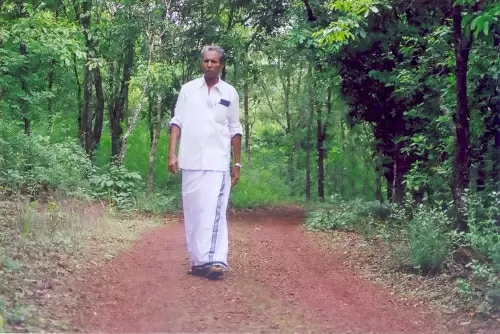He lives in the thick of a forest, created by him

17-September-2010
Vol 1 | Issue 3
Since 1986, P Abdul Kareem lives inside a 32-acre forest, which is host to hundreds of bee-hives, snake pits and nests. Point out any wild tree to him and he comes out with its local and botanical name instantly. Of course, it’s not something one needs to be surprised about. For, Kareem is not just the owner of the forest but also its creator.
Kerala's Forest Research Institute sends scientists to study the trees planted by him and the state’s textbook committee has introduced a chapter on this 'man-made forest' in the sixth standard textbook.
 |
|
Green Paradise: The forest is a dream come true for Abdul Kareem
|
Agricultural scientist, M S Swaminathan, who once stopped by, has been a frequent visitor ever since. And Kareem was one of the 20 persons honoured in 2009 by Limca Book of Records as "People of the Year".
In 2005, Indian Oil Corporation released a full-page newspaper ad in its 'India Inspired' series, extolling Kareem's efforts, and followed it up by gifting him a fuel station to sustain his conservation efforts. However, behind Kareem’s success lies a strong will and years of hard work, propelled by a dream.
When Kareem first set his eyes on the lateritic hillside during his weekend getaways at his wife’s house in Puliyankulam, the entire stretch was barren. In 1977, he bought five acres of land with an almost non-functional well for Rs 3,750.
Next year, he planted mature saplings of wild trees, but all of them withered soon. The second attempt too was unsuccessful. However, in the third attempt, several saplings survived and started growing.
In those days, Kareem used to fetch water in cans on his motorbike from a source a kilometre away - several times a day. He cared for passing birds too. He put small water-filled pots around the land to attract them. They brought in more diversity to his land, discharging varied seeds through droppings.
He planted 800 species of forest trees and 300 medicinal plants. He has never weeded his land, never cut a tree, never swept or set on fire the leaves ever since. “The most important revelation for me was the impact of humus on the hard rock.
The fallen leaves form a thick layer on the rocky surface and get decomposed over the years. This accelerated the disintegration of laterite into small gravel and slowly to fine soil which in turn helps seeds spread by the insects and birds to grow roots and germinate,” he says.
He kept away all fertilizers, insecticides and pesticides. He dug rainwater catch pits and raised walls with boulders across the slopes in order to capture soil carried by run-off water.
Soon, the ground water rose to a comfortable level. He stepped up his efforts. Weeds grew amidst the rare herbs and medicinal plants – many not chosen by Kareem. In 1982, he bought another 27 acres of rocky land and today, “you dig five metres and you'll get water here,” says Kareem.
With hare, fowl and other small game appearing in the forests and sack-sized beehives emerging, Kareem built his house inside the forest in 1986. From a tank in the forest, he can now pump 100,000 litres at one go and the level will bounce back in a few minutes.
Today, Kareem supplies drinking water to the 100-odd families from the two wells and four ponds in his forest, situated in Puliyankulam.
















